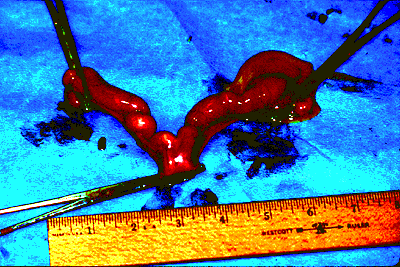| ABNORMAL
EVENTS OF THE FELINE LUTEAL PERIOD
 464-469 464-469

Pyometra
- Pyometra is a common disorder associated with the
luteal period.
 The pathogenesis of pyometra is probably not
rooted in the luteal phase, but in the multiple exposures to
estrogen when the queen is cycling frequently and not induced to
ovulate. This repeated exposure to estrogen results in endometrial
hyperplasia. The pathogenesis of pyometra is probably not
rooted in the luteal phase, but in the multiple exposures to
estrogen when the queen is cycling frequently and not induced to
ovulate. This repeated exposure to estrogen results in endometrial
hyperplasia.
- The endometrial hyperplasia predisposes queens to
pyometra when a luteal phase occurs. In one study, almost all
queens greater than five years old (the mean age being 6.3 years)
had evidence of endometrial hyperplasia.
- The mean age of queens with pyometra is 7.2 to
7.6 years.
Clinical Signs

- The primary clinical signs of pyometra include
abdominal distension, vaginal discharge, anorexia, weight change
and lethargy.
- Queens with corpora lutea on the ovaries have a
neutrophilic leukocytosis with a total white count averaging
57,000/µl, whereas those without corpora lutea have a white count
averaging 25,000/µl.
- Abdominal radiographs or ultrasound will help in
determining if the uterus is enlarged.
- Only about 20% of queens with pyometra have
bacteriologic growth from the pyometra fluid.
- The most commonly isolated organisms is Eschericha
coli.
Treatments
- Treatments for pyometra include
ovariohysterectomy, prostaglandins and surgical uterine lavage.
- Ovariohysterectomy is the treatment of choice for
queens that are not intended for breeding.
- For queens with breeding potential, medical
treatment with prostaglandins is preferred.
- Prostaglandin F2alpha at a dosage of 200 µg/kg/day IM for 2 days followed by 500 µg/kg/day
for 3 days combined a with broad spectrum antibiotic is an
effective treatment and can restore fertility.
- An increase in
vaginal discharge is often noted within 15 minutes to 3 hours
after treatment.
- Transient side effects with prostaglandin
treatment include defecation and vomiting.
- Relative circulatory
hypovolemia, as seen in the dog following prostaglandin therapy,
has not been reported in the cat. The side effects and vaginal
discharge usually diminish with each subsequent treatment.
- Because of the reported success of prostaglandin
therapy for pyometra, treatment by surgical uterine lavage may
only be warranted for those cases refractory to prostaglandin
treatment.
Prevention
- Prevention of pyometra includes strategies to
minimize the number of exposures to estrogen dominance. These
strategies include inducing ovulation, breeding at estrus to keep
the queen pregnant or in pseudopregnancy, manipulating lighting so
the queen will remain in anestrus, or preventing estrus
pharmacologically.
Other Diseases
- Other diseases seen during the luteal phase
include endometritis and hydrometra.
- Endometritis may be an early stage in the
development of pyometra as clinical signs may be similar, but the
uterine pathology is not as severe.
- Hydrometra is a collection of nonpurulent fluid
in the uterus. These two conditions are treated the same as
pyometra.
Fibroadenometous Mammary
Hyperplasia
 474-477 474-477
-
Click here to go to Brazilian study and
see a picture.
-
Fibroadenometous mammary hyperplasia is
characterized by the enlargement of the mammary glands resulting
from the progesterone phase in young queens (pregnancy or
pseudopregnancy) and exogenous progestagens in older queens.
- The enlarged mammary glands are very firm and may
succumb to secondary mastitis or traumatic ulceration.
- Regression has been reported following pregnancy
and lactation.
- Since this condition is associated with
progesterone domination, the treatment of choice should eliminate
the progesterone stimulation by ovariohysterectomy.
- 10 mg/kg aglepristone
(Alizine; Virbac), a
progesterone-receptor blocker, for five
consecutive days and then again on the
seventh day has been reproted to help.
- Two days after the
onset of treatment, a reduction in the
size of the mammary glands was observed
- Significant
regression was seen on day 6.
- Complete involution
of the glands was achieved four weeks
after the initial treatment
- Lower doses of (0.1
mg/kg s.c. q24 hrs and then 5.0 mg/kg s.c three weeks later) have reported
efficacious.
- Surgery during the acute phase is not warranted
as the condition normally will subside spontaneously.
Administration of progestational hormones should be avoided.
|


